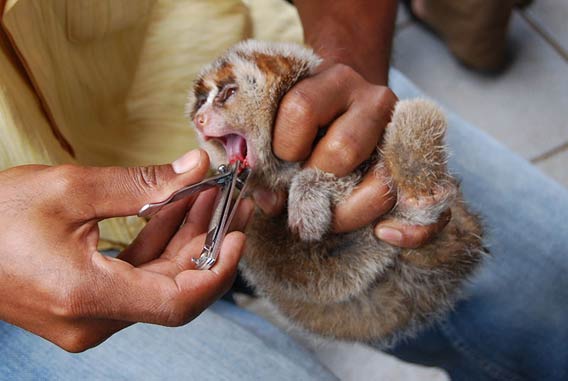-Arun-Kanagavel.568.jpg)
Slender loris. Photo by: Arun Kanagavel.
Caught in a beam of torchlight, the eyes of the slender loris reflect back a striking glow. In an effort to better understand these shy, nocturnal primates, a team of researchers set out to the Western Ghats of India. The resulting paper: Moolah, Misfortune or Spinsterhood? The Plight of the Slender Loris (Loris lydekkerianus) in Southern India was published in the Journal of Threatened Taxa in January of 2013. Forest walks and interviews with the Kani people, who live in close proximity to the lorises, supported evidence of a surprising new threat to the lorises: photographers.
Endemic to both the Eastern and Western Ghats, the gray slender loris is represented by two subspecies, Loris lydekkerianus lydekkerianus and Loris lydekkerianus malabaricus. These insectivorous animals are distributed throughout wet evergreen forests, particularly in scrub forests and plantations and occur in greatest abundance in disturbed areas. Both subspecies are listed as a Least Concern Species by the IUCN Red List, and protected under the Indian Wildlife Act.
Despite their protected status the soft and wide-eyed loris, popularized by viral YouTube videos and Internet photos, has become a major commodity in the illegal pet trade. But, their live insect diet makes caring for them difficult and incredibly sensitive lorises do not fare well in captivity. Lorises are also surrounded by myth and folklore. Some lorises are captured for their purported medicinal properties, though this is becoming less common. Among the Kani people, at least, the loris is seen as a bad omen; an unmarried woman who glances at the animal is doomed to life-long spinsterhood, and a loris sighting in the forest predicts bad luck for the harvest of non-timber forest products.
Photographers from around the world are eager to capture shots of this charismatic primate, yet the elusive and strictly nocturnal habits of the slender loris make them difficult to track down. Photographers are willing to pay substantial sums for a “managed” photo shoot with the animals. The Kani use bright lights, scare tactics, and even tree cutting methods to capture the animals. Locals often bring the captured loris into the village where it is held for several days (in a place where it will not be mistakenly glanced upon by a women). Once a shoot is completed, the loris is typically re-released just outside of the village, far from their capture sights and away from a contiguous strip of forest that could shelter their passage back to ideal habitat.
According to the paper, “This type of photography practice not only endangers a species protected under the Indian Wildlife Act, but also promotes cultural and emotional discomfort among local communities, whose proximity to wildlife only presents an increases risk to wildlife conservation in this case.”
“If animals are to be handled I would suggest prior permission be taken from the concerned Forest Department,” lead author Arun Kanagavel told mongabay.com. “Capture and release sites should also be the same. As far as possible handling these shy primates should be disallowed and instead loris-watching treks can be arranged to observe them in the wild and photograph them naturally. Also the type of torch lights that would go on to be used during such initiatives would need regulation.”
Aside from the regulation of photography, handling, and torch use, the paper calls for urgent surveys to understand the distribution and status of the slender loris in the Western Ghats to better inform conservation strategists.
India’s Western Ghats boast a treasure-trove of biodiversity, and its rainforests have been recently listed as a UNESCO World Heritage site. Yet despite its biological riches, or perhaps because of, the Ghats are riddled with conservation controversies. A tenuous balance between wildlife and agriculture has played out for centuries, yet deforestation, illegal harvesting of non-forest timber products, poaching, and the pet trade have taken their toll. The wide variety of peoples, bioregions, strategies for land management and inconsistent environmental regulations have made both science and conservation in the area a complicated matter.
Says Arun Kanagavel, “The project revealed to me how crucial human communities are while considering wildlife conservation. The indigenous locals were so adept at spotting the primates. The inter-dependence of urban and local indigenous communities came to the forefront.”

Nocturnal, sensitive, and with a highly-specialized diet grey slender loris should not be taken out of the wild. Photo by: Arun Kanagavel.

Slow lorises like this Sunda Slow Loris juvenile (Nycticebus coucang) have their teeth forcibly removed by animal traffickers in the open-air bird markets of Indonesia. The practice is done to either convince buyers that the animal is suitable as a child’s pet or to make people think the animal is an infant. This photo was taken by Dr. Karmele Llano Sánchez of the International Animal Rescue (IAR).
CITATION: Kanagavel, A., Sinclair, C., Rajkumar, S., Raghave R. Moolah, Misfortune or Spinsterhood? The Plight of the Slender Loris (Loris lydekkerianus) in Southern India. Journal of Threatneed Taxa . January 2013. 3585-3588.
Related articles
Recommendations to save India’s Western Ghats creates political stir

(08/20/2012) A massive expert panel report on the conservation of the Western Ghats has caused a political stir in India. The report, headed by noted ecologist Madhav Gadgil, recommends that the government phase out mining projects, cancel damaging hydroelectric projects, and move toward organic agriculture in ecologically-sensitive sections of the Ghats. The report, which was leaked after the government refused to release it, has yet to be implemented. Recently dubbed a UNESCO World Heritage Site, the Western Ghats is one of India’s largest wildernesses and home to thousands of species, many found no-where else.
India’s Western Ghats rainforest declared UNESCO World Heritage Site
(07/03/2012) India’s Western Ghats, considered one of the richest biodiversity hotspots in the world, has been dubbed a UNESCO World Heritage Site. In total, 39 different sites in the tropical rainforest—home to Asian elephants, Bengal tigers, lion-tailed macaques, and thousands of other species—have made it under the listing.
Photos: 10 new frogs discovered in India’s great rainforest

(08/09/2011) Ten new species of frog have been discovered in India’s Western Ghats according to two new papers in Biosystematica. Although human populations have farmed in the Western Ghats for centuries, the new discoveries prove that the rainforest still holds many surprises. The Western Ghats lie along India’s west coast and have been dubbed one of the world’s biodiversity hotspots, but the rich wildlife is imperiled by rising human impacts.
Balancing agriculture and rainforest biodiversity in India’s Western Ghats

(08/08/2011) When one thinks of the world’s great rainforests the Amazon, Congo, and the tropical forests of Southeast Asia and Indonesia usually come to mind. Rarely does India—home to over a billion people—make an appearance. But along India’s west coast lies one of the world’s great tropical forests and biodiversity hotspots, the Western Ghats. However it’s not just the explosion of life one finds in the Western Ghats that make it notable, it’s also the forest’s long—and ongoing—relationship to humans, lots of humans. Unlike many of the world’s other great rainforests, the Western Ghats has long been a region of agriculture. This is one place in the world where elephants walk through tea fields and tigers migrate across betel nut plantations. While wildlife has survived alongside humans for centuries in the region, continuing development, population growth and intensification of agriculture are putting increased pressure on this always-precarious relationship. In a recent paper in Biological Conservation, four researchers examine how well agricultural landscapes support biodiversity conservation in one of India’s most species-rich landscapes.